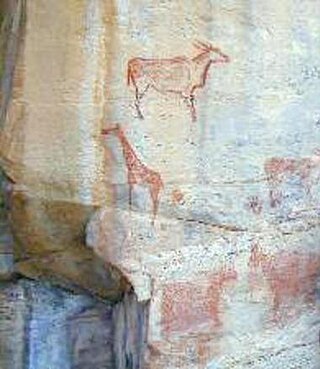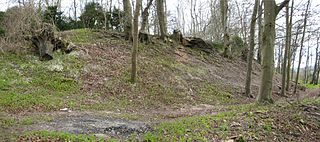
William Hunt and Sons or WHS is a British brand of masonry tools and other types of edge tools. The WHS 4" pointing trowel is well known as a standard excavation implement in British archaeology. [1]

William Hunt and Sons or WHS is a British brand of masonry tools and other types of edge tools. The WHS 4" pointing trowel is well known as a standard excavation implement in British archaeology. [1]
The founder of the company, William Hunt, was an edge tool maker at Rowley Regis, near Dudley, Worcestershire, in the late 18th century. In 1782 he purchased the Brades Estate at Oldbury, near Birmingham, and established a new works there known as Brades Forge, or simply as The Brades. By 1805 they were also manufacturing steel on the site, which was now known as the Brades Steel Works. Around 1793, Hunt took W. Cliffe into partnership, and for a short period the firm was known as Hunt and Cliffe: this name appears in the company's first ledger, dated 9 May 1794. This partnership dissolved around 1803, and Hunt continued trading on his own account until 1809, when he took his sons into partnership and the firm became known as William Hunt & Sons.
In 1828 the company acquired William Edwards and Sons (incorporating the Eagle Edge Tool Company), and later the business of Bache Bros, [2] spade makers of Churchill Forge, near Stourbridge. In the late 19th century George Heaton became a major shareholder in the company.
In 1951 the company amalgamated with Nash Tyzack to form Brades Nash Tyzack Industries, and later took over the business of Skelton. In 1962, together with Harrison, they became part of Spear & Jackson, who in 1967 also acquired Edward Elwell Ltd, all the companies coming together as parts of S&J by 1972. In 1985 S&J became part of the Neill Tools Group based in Sheffield, who still own the brand today.
The company's major UK trade marks were BRADES and WHS, but they had many others, some of which, such as Eagle, Giraffe and Pagoda, were only used on tools made for export.

The WHS pointing trowel is prized amongst archaeologists in the United Kingdom who find its strength useful in digging heavy deposits. In his 1946 book Field Archaeology, Richard J. C. Atkinson (best known for excavating Stonehenge), "unequivocally" recommended the use of a trowel for archaeology; during the postwar era, WHS and a competing brand from Bowden were predominant. By 1960, archaeologist Paul Stamper was told that a WHS trowel was a "prerequisite", and by 1999, he deemed it the "industry standard". [3] Current Archaeology summed up the choices:
There are really only two contenders on the single-forged blade market, WHS (UK) and Marshalltown (US). WHS blades are thicker, but consequently become blunt as they start to wear down. Marshalltown blades are sharp, flexible, and strong enough to deal with most types of soil. [4]
In 2005, the company introduced a new version of its 4" WHS pointing trowel. [5] The thinner and more brittle design was designed for the construction industry, and encountered resistance from archaeologists who found it inferior to its predecessor model. [5] Oxford Archaeology indicated it might switch to the American-made Marshalltown trowel; and British Archaeological Jobs Resource received complaints of breakages on site. In response, in the summer of 2006, the firm launched a new trowel, marked "Archaeologists' Trowel" on the blade, the design of which took account of archaeologists' concerns and the results of field trials. It incorporated a thicker, stronger blade, higher lift for extra knuckle clearance, and a flattened tang to prevent handle rotation.
The Copper Age, also called the Chalcolithic or (A)eneolithic, is an archaeological period characterized by regular human manipulation of copper, but prior to the discovery of bronze alloys. Modern researchers consider the period as a subset of the broader Neolithic, but earlier scholars defined it as a transitional period between the Neolithic and the Bronze Age. It is also considered the first phase, of three, in the Metal Ages.

Pattern welding is the practice in sword and knife making of forming a blade of several metal pieces of differing composition that are forge-welded together and twisted and manipulated to form a pattern. Often mistakenly called Damascus steel, blades forged in this manner often display bands of slightly different patterning along their entire length. These bands can be highlighted for cosmetic purposes by proper polishing or acid etching. Pattern welding was an outgrowth of laminated or piled steel, a similar technique used to combine steels of different carbon contents, providing a desired mix of hardness and toughness. Although modern steelmaking processes negate the need to blend different steels, pattern welded steel is still used by custom knifemakers for the cosmetic effects it produces.

Michael Antony Aston was an English archaeologist who specialised in Early Medieval landscape archaeology. Over the course of his career, he lectured at both the University of Bristol and University of Oxford and published fifteen books on archaeological subjects. A keen populariser of the discipline, Aston was widely known for appearing as the resident academic on the Channel 4 television series Time Team from 1994 to 2011.

Oldbury is a market town in the Metropolitan Borough of Sandwell, West Midlands, England. It is the administrative centre of the borough and one of its six constituent towns.

The River Tame is a river in the West Midlands of England, and one of the principal tributaries of the River Trent. The Tame is about 95 km (59 mi) long from the source at Oldbury to its confluence with the Trent near Alrewas, but the main river length of the entire catchment, i.e. the Tame and its main tributaries, is about 285 km (177 mi).

A hoe is an ancient and versatile agricultural and horticultural hand tool used to shape soil, remove weeds, clear soil, and harvest root crops. Shaping the soil includes piling soil around the base of plants (hilling), digging narrow furrows (drills) and shallow trenches for planting seeds or bulbs. Weeding with a hoe includes agitating the surface of the soil or cutting foliage from roots, and clearing the soil of old roots and crop residues. Hoes for digging and moving soil are used to harvest root crops such as potatoes.

A trowel is a small hand tool used for digging, applying, smoothing, or moving small amounts of viscous or particulate material. Common varieties include the masonry trowel, garden trowel, and float trowel.

Tividale is a district of the Metropolitan Borough of Sandwell, West Midlands.

Wilkinson Sword is a formerly British brand for razors and other personal care products sold in Europe, owned by the US company Edgewell Personal Care. The company was founded as a manufacturer of guns made in Shotley Bridge in County Durham, by Henry Nock in London in 1772.
David Lennox was an American inventor and businessman. A furnace manufacturing business he founded in 1895 in Marshalltown, Iowa evolved into what is today known as Lennox International, a global corporation specializing in air conditioning, heating, and commercial refrigeration. Lennox helped to develop what has been described as the first riveted-steel furnace in 1895. His contributions to furnace design have been described as significant steps forward in durability and efficiency from the cast iron furnaces commonly in use near the end of the 19th century.

The Tsodilo Hills are a UNESCO World Heritage Site (WHS), consisting of rock art, rock shelters, depressions, and caves in southern Africa. It gained its WHS listing in 2001 because of its unique religious and spiritual significance to local peoples, as well as its unique record of human settlement over many millennia. UNESCO estimates there are over 4500 rock paintings at the site. The site consists of a few main hills known as the Child Hill, Female Hill, and Male Hill.
Accles & Pollock is a British tube manipulation company based in Oldbury, West Midlands.

Bladesmithing is the art of making knives, swords, daggers and other blades using a forge, hammer, anvil, and other smithing tools. Bladesmiths employ a variety of metalworking techniques similar to those used by blacksmiths, as well as woodworking for knife and sword handles, and often leatherworking for sheaths. Bladesmithing is an art that is thousands of years old and found in cultures as diverse as China, Japan, India, Germany, Korea, the Middle East, Spain and the British Isles. As with any art shrouded in history, there are myths and misconceptions about the process. While traditionally bladesmithing referred to the manufacture of any blade by any means, the majority of contemporary craftsmen referred to as bladesmiths are those who primarily manufacture blades by means of using a forge to shape the blade as opposed to knifemakers who form blades by use of the stock removal method, although there is some overlap between both crafts.
Rubery Owen is a British engineering company which was founded in 1884 in Darlaston, West Midlands.

Churchill Forge Mill, situated in the Worcestershire village of Churchill, is one of the last water-powered forge mills remaining in an intact state in the UK and as such is an important example of the industrial heritage of the West Midlands. Part of the site has been restored to working condition and is now maintained and operated by the Churchill Forge Trust.
Twyford Bathrooms is a manufacturer of bathroom fixtures based in Alsager, Cheshire, England.
The 'Marshalltown Company, based in Marshalltown, Iowa, is a privately held American manufacturer of construction tools and equipment used for archaeology, asphalt, concrete, drywall, EIFS, flooring, masonry, painting, plastering, stucco, tile, and wallpaper. Marshalltown, founded in 1890, was one of the top producers of construction tools and equipment in the world, including the Marshalltown pointing trowel, a tool often used by American archaeologists.

Vespasian's Camp is an Iron Age hillfort just west of the town of Amesbury, Wiltshire, England. The hillfort is less than 3 kilometres (2 mi) from the Neolithic and Bronze Age site of Stonehenge, and was built on a hill next to the Stonehenge Avenue; it has the River Avon on its southern side and the A303 road on its northern edge. The site is a scheduled monument and lies within the boundaries of the Stonehenge World Heritage Site.
John Sadler was an English industrialist and public figure associated with the town of Oldbury, Worcestershire, United Kingdom. As a result of his lifetime of service, Sadler became known as 'the Grand Old Man of Oldbury'.
The Wellman Group is a group of manufacturing companies that make boilers and advanced defence equipment. It is one of the main boilermakers in the UK, if not the most common for large-scale industrial applications, having taken over many well-known boiler companies.